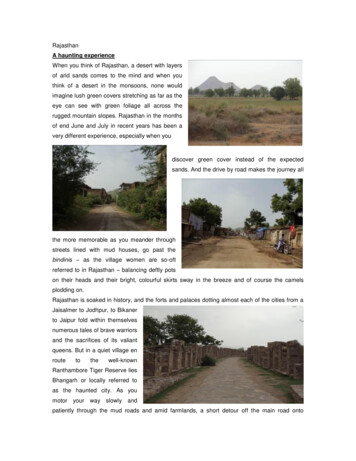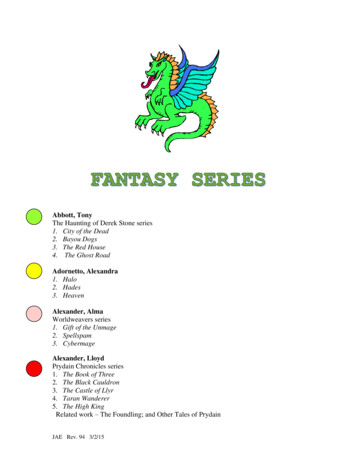
Transcription
RajasthanA haunting experienceWhen you think of Rajasthan, a desert with layersof arid sands comes to the mind and when youthink of a desert in the monsoons, none wouldimagine lush green covers stretching as far as theeye can see with green foliage all across therugged mountain slopes. Rajasthan in the monthsof end June and July in recent years has been avery different experience, especially when youdiscover green cover instead of the expectedsands. And the drive by road makes the journey allthe more memorable as you meander throughstreets lined with mud houses, go past thebindinis – as the village women are so-oftreferred to in Rajasthan – balancing deftly potson their heads and their bright, colourful skirts sway in the breeze and of course the camelsplodding on.Rajasthan is soaked in history, and the forts and palaces dotting almost each of the cities from aJaisalmer to Jodhpur, to Bikanerto Jaipur fold within themselvesnumerous tales of brave warriorsand the sacrifices of its valiantqueens. But in a quiet village enroutetothewell-knownRanthambore Tiger Reserve liesBhangarh or locally referred toas the haunted city. As youmotor yourway slowly andpatiently through the mud roads and amid farmlands, a short detour off the main road onto
another narrow lane takes you to another world – a world so different and so nestled deep intothe mountains and literally the sands of time that it almost seems a lost civilization. And a lostcivilization it is ensconced in the walled ruins of what once was the seat of the warrior general ofthRajasthan. This ancient township was founded in the later half of 16 century by Raja BhagwantSingh, the then ruler of the princely town of Amber. It later became the capital of Raja MadhoSingh, who was a Diwan or a Counsellor in the court of the Mughal Emperor, Akbar (A.D 1556 –1605). Bhangarh beckons you even on a hot summer afternoon.As you cross the entry gate,be ready to move into adifferent era. It is inviting, it iseerie but it is breathtaking asyou take your first steps ontothe ancient streets that guideyouwithwell-markedsignages that read – fort,jauhri or the crafts bazaar,temple and more and all inruins. The first glance offersyou a panoramic view of a township once bustling with life, artistic works and trading. The welldefined contours of Bhangarh start becoming evident as you saunter along the cobbled route,which has a series of equal size kiosks in two rows running parallel to each other.Move away from jauhri bazaar and you come again to single rows of parallel gates facing eachother lining a cobbled street. Beyond these garland like row of gates are steps leading to an openplatform. Interestingly, each of the quarters looks similar and extremely finely planned. Quitesurprisingly, the roofs of most structuresare not there. It almost seems as if in asingle slice the entire city-village hadbeen beheaded. And there hangs a tale.No one till date is permitted to enter intothis ruined city-village before sunrise orafter sunset. The Archeological Survey ofIndia’s Office is also located outside thelimits of Bhangarh. It is said thatBhangarhwascursedbyasaint.
Spurned by the princess of the land, he cursed the city-village, which invited his wrath. Cursed itwas that it got destroyed overnight – so goes the story. It is difficult to understand that amidst aruined township, how the beautifully carved temples stand intact.History and stories of yore lace the winding dustyand cobbled pathways. Yet the remnants of thecity-village are so perfectly evident that you canconjure images of a dwelling resonating withenergy, people, voices and war . Crossingthe meandering pathways, you again movethrough another iron gate and large acres of open,green lawns greet you. Standing in the midst ofthese lawns, you can see temples around built innagara style architecture, marketplace, dwellings.And a few step forward, an imposing fortembedded in the rocky mountains stands atopyou. It beckons you and invites you to explore thedeeper reaches of history.Believed to be originally with seven storeys,only five are visible today. Interestingly inRajasthan, the larger cities boast of hugepalaces adorned with beatific engravings andprecious jewels. This in contrast, the palacefort in Bhangarh shorn of design andsplendour stands raw and naked – built in solidrock – almost as if boasting of the numerous warsthat it has weathered. Immediately, you aretempted to climb the rows of steps to reach its
inner precincts. Whilst the outer façade of the fort stands strong, the inside is quite in ruin. Theview of the Bhangah from the fort is, however, simply splendid and very imposing. Imagine theking - or the Diwan in this case - standing aloft in the fort-palace proudly surveying his city, hispeople, the happiness. The structures are all well-separated by distances – large enough to markthe limits of the walled township and yet at the same time, each of the structures – fort-palace,temples, marketplace, residential areas – seems cohesively integrated into a well-plannedtownship. Interestingly, Bhangarh has known fewer tourists as it is nestled deep into the forest,mountainous area, off the tracks of any of the main city routes. The sparse populace that you docome across comprises the folk from nearby villages that is attracted to the township more by itshaunting tales, and a few tourists, largely foreigners resident in the nearby luxurious Amanbaghresort, who saunter into Bhangarh in search of a quiet trek.Spend a day in Bhangarh from sunrise till sunset and feel history, which is palpable and almosttouching or shall I say haunting. Bhangarh invites you. Experience India!Directions:From Delhi – Between Manoharpur - DausaOn NH8, from Delhi turn left from Manoharpur ( 196Km) just visibly short of AjmerSikar Expressway.Manoharpur – Pratapgargh – Ajabgargh – Bhangargh - Dausa(MapmyIndia – CE Info Systems)Bhangarh
civilization it is ensconced in the walled ruins of what once was the seat of the warrior general of Rajasthan. This ancient township was founded in the later half of 16th century by Raja Bhagwant Singh, the then ruler of the princely town of Amber. It later became the capital of Raja Madho Singh, who was a Diwan or a Counsellor in the court of the Mughal Emperor, Akbar (A.D 1556 – 1605 .











